Annotated Bibliography on Fashion Brands and Social Media Marketing
VerifiedAdded on 2023/06/11
|6
|1805
|359
AI Summary
This annotated bibliography explores the relationship between fashion brands and social media marketing, specifically on Instagram. It includes articles on consumer engagement, brand impression management, and the influence of social media on fashion brands. The bibliography also includes a film on the tea party movement and a documentary on the legal struggle to overturn California's Proposition 8.
Contribute Materials
Your contribution can guide someone’s learning journey. Share your
documents today.
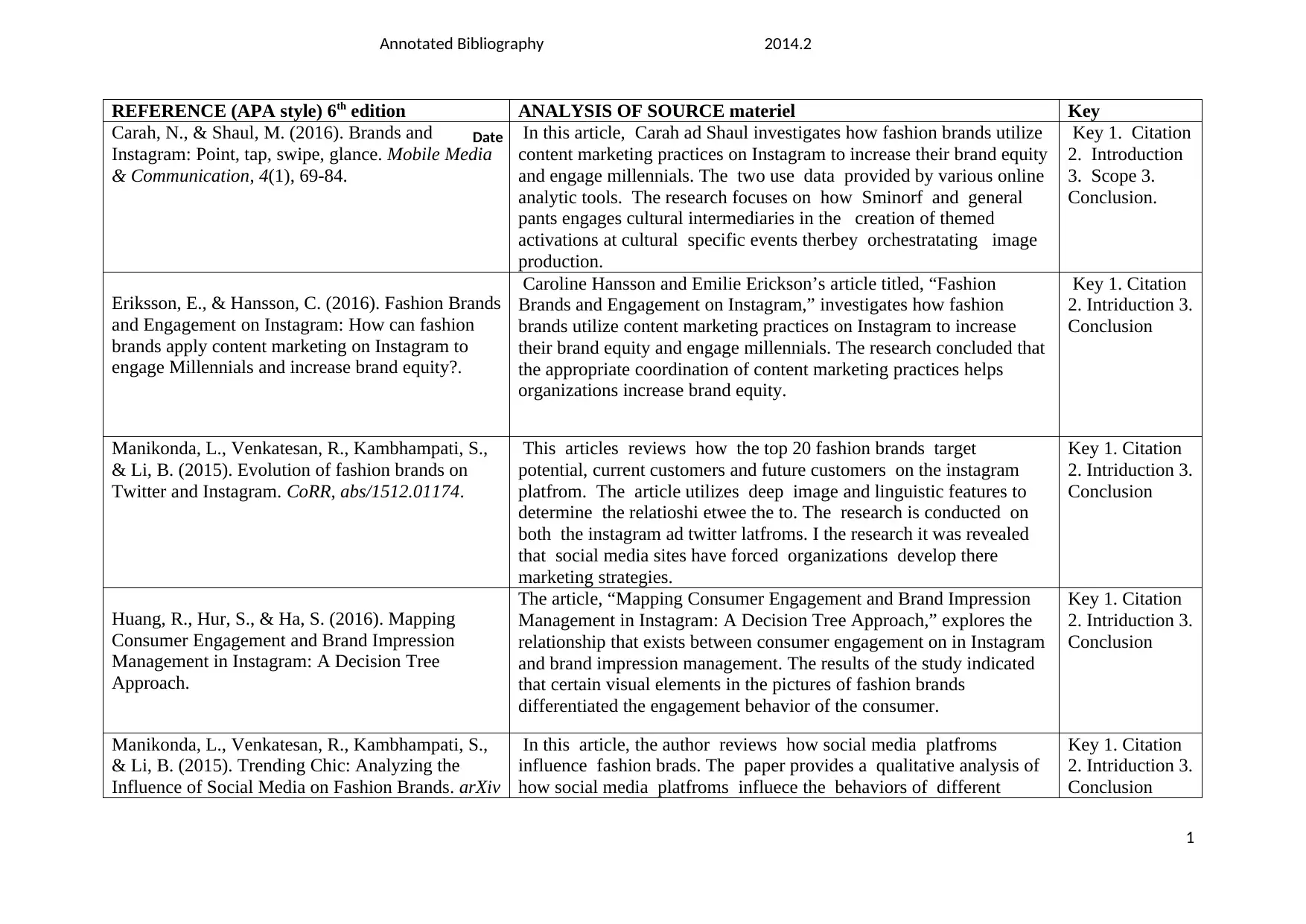
Date
Annotated Bibliography 2014.2
REFERENCE (APA style) 6th edition ANALYSIS OF SOURCE materiel Key
Carah, N., & Shaul, M. (2016). Brands and
Instagram: Point, tap, swipe, glance. Mobile Media
& Communication, 4(1), 69-84.
In this article, Carah ad Shaul investigates how fashion brands utilize
content marketing practices on Instagram to increase their brand equity
and engage millennials. The two use data provided by various online
analytic tools. The research focuses on how Sminorf and general
pants engages cultural intermediaries in the creation of themed
activations at cultural specific events therbey orchestratating image
production.
Key 1. Citation
2. Introduction
3. Scope 3.
Conclusion.
Eriksson, E., & Hansson, C. (2016). Fashion Brands
and Engagement on Instagram: How can fashion
brands apply content marketing on Instagram to
engage Millennials and increase brand equity?.
Caroline Hansson and Emilie Erickson’s article titled, “Fashion
Brands and Engagement on Instagram,” investigates how fashion
brands utilize content marketing practices on Instagram to increase
their brand equity and engage millennials. The research concluded that
the appropriate coordination of content marketing practices helps
organizations increase brand equity.
Key 1. Citation
2. Intriduction 3.
Conclusion
Manikonda, L., Venkatesan, R., Kambhampati, S.,
& Li, B. (2015). Evolution of fashion brands on
Twitter and Instagram. CoRR, abs/1512.01174.
This articles reviews how the top 20 fashion brands target
potential, current customers and future customers on the instagram
platfrom. The article utilizes deep image and linguistic features to
determine the relatioshi etwee the to. The research is conducted on
both the instagram ad twitter latfroms. I the research it was revealed
that social media sites have forced organizations develop there
marketing strategies.
Key 1. Citation
2. Intriduction 3.
Conclusion
Huang, R., Hur, S., & Ha, S. (2016). Mapping
Consumer Engagement and Brand Impression
Management in Instagram: A Decision Tree
Approach.
The article, “Mapping Consumer Engagement and Brand Impression
Management in Instagram: A Decision Tree Approach,” explores the
relationship that exists between consumer engagement on in Instagram
and brand impression management. The results of the study indicated
that certain visual elements in the pictures of fashion brands
differentiated the engagement behavior of the consumer.
Key 1. Citation
2. Intriduction 3.
Conclusion
Manikonda, L., Venkatesan, R., Kambhampati, S.,
& Li, B. (2015). Trending Chic: Analyzing the
Influence of Social Media on Fashion Brands. arXiv
In this article, the author reviews how social media platfroms
influence fashion brads. The paper provides a qualitative analysis of
how social media platfroms influece the behaviors of different
Key 1. Citation
2. Intriduction 3.
Conclusion
1
Annotated Bibliography 2014.2
REFERENCE (APA style) 6th edition ANALYSIS OF SOURCE materiel Key
Carah, N., & Shaul, M. (2016). Brands and
Instagram: Point, tap, swipe, glance. Mobile Media
& Communication, 4(1), 69-84.
In this article, Carah ad Shaul investigates how fashion brands utilize
content marketing practices on Instagram to increase their brand equity
and engage millennials. The two use data provided by various online
analytic tools. The research focuses on how Sminorf and general
pants engages cultural intermediaries in the creation of themed
activations at cultural specific events therbey orchestratating image
production.
Key 1. Citation
2. Introduction
3. Scope 3.
Conclusion.
Eriksson, E., & Hansson, C. (2016). Fashion Brands
and Engagement on Instagram: How can fashion
brands apply content marketing on Instagram to
engage Millennials and increase brand equity?.
Caroline Hansson and Emilie Erickson’s article titled, “Fashion
Brands and Engagement on Instagram,” investigates how fashion
brands utilize content marketing practices on Instagram to increase
their brand equity and engage millennials. The research concluded that
the appropriate coordination of content marketing practices helps
organizations increase brand equity.
Key 1. Citation
2. Intriduction 3.
Conclusion
Manikonda, L., Venkatesan, R., Kambhampati, S.,
& Li, B. (2015). Evolution of fashion brands on
Twitter and Instagram. CoRR, abs/1512.01174.
This articles reviews how the top 20 fashion brands target
potential, current customers and future customers on the instagram
platfrom. The article utilizes deep image and linguistic features to
determine the relatioshi etwee the to. The research is conducted on
both the instagram ad twitter latfroms. I the research it was revealed
that social media sites have forced organizations develop there
marketing strategies.
Key 1. Citation
2. Intriduction 3.
Conclusion
Huang, R., Hur, S., & Ha, S. (2016). Mapping
Consumer Engagement and Brand Impression
Management in Instagram: A Decision Tree
Approach.
The article, “Mapping Consumer Engagement and Brand Impression
Management in Instagram: A Decision Tree Approach,” explores the
relationship that exists between consumer engagement on in Instagram
and brand impression management. The results of the study indicated
that certain visual elements in the pictures of fashion brands
differentiated the engagement behavior of the consumer.
Key 1. Citation
2. Intriduction 3.
Conclusion
Manikonda, L., Venkatesan, R., Kambhampati, S.,
& Li, B. (2015). Trending Chic: Analyzing the
Influence of Social Media on Fashion Brands. arXiv
In this article, the author reviews how social media platfroms
influence fashion brads. The paper provides a qualitative analysis of
how social media platfroms influece the behaviors of different
Key 1. Citation
2. Intriduction 3.
Conclusion
1
Secure Best Marks with AI Grader
Need help grading? Try our AI Grader for instant feedback on your assignments.
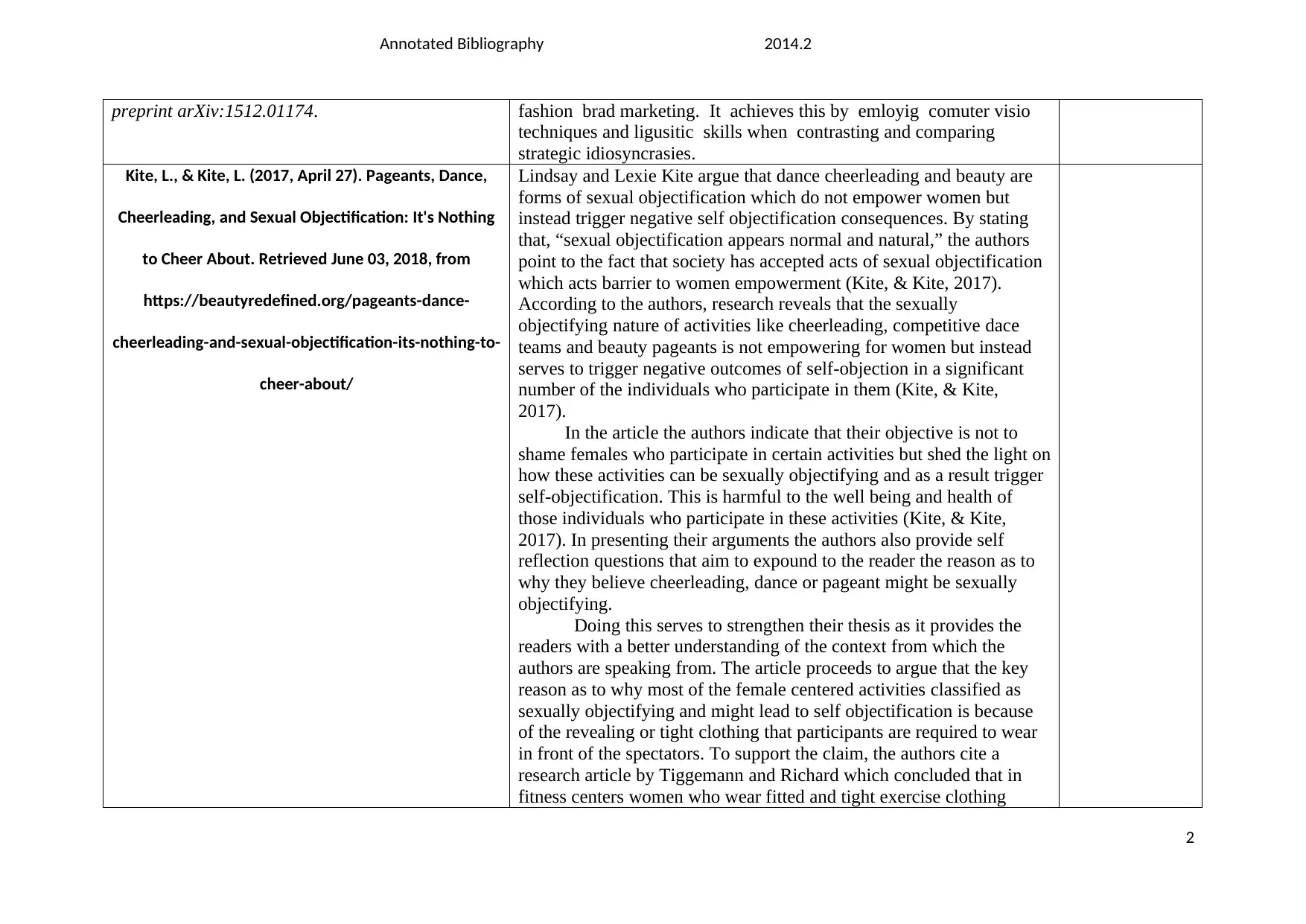
Annotated Bibliography 2014.2
preprint arXiv:1512.01174. fashion brad marketing. It achieves this by emloyig comuter visio
techniques and ligusitic skills when contrasting and comparing
strategic idiosyncrasies.
Kite, L., & Kite, L. (2017, April 27). Pageants, Dance,
Cheerleading, and Sexual Objectification: It's Nothing
to Cheer About. Retrieved June 03, 2018, from
https://beautyredefined.org/pageants-dance-
cheerleading-and-sexual-objectification-its-nothing-to-
cheer-about/
Lindsay and Lexie Kite argue that dance cheerleading and beauty are
forms of sexual objectification which do not empower women but
instead trigger negative self objectification consequences. By stating
that, “sexual objectification appears normal and natural,” the authors
point to the fact that society has accepted acts of sexual objectification
which acts barrier to women empowerment (Kite, & Kite, 2017).
According to the authors, research reveals that the sexually
objectifying nature of activities like cheerleading, competitive dace
teams and beauty pageants is not empowering for women but instead
serves to trigger negative outcomes of self-objection in a significant
number of the individuals who participate in them (Kite, & Kite,
2017).
In the article the authors indicate that their objective is not to
shame females who participate in certain activities but shed the light on
how these activities can be sexually objectifying and as a result trigger
self-objectification. This is harmful to the well being and health of
those individuals who participate in these activities (Kite, & Kite,
2017). In presenting their arguments the authors also provide self
reflection questions that aim to expound to the reader the reason as to
why they believe cheerleading, dance or pageant might be sexually
objectifying.
Doing this serves to strengthen their thesis as it provides the
readers with a better understanding of the context from which the
authors are speaking from. The article proceeds to argue that the key
reason as to why most of the female centered activities classified as
sexually objectifying and might lead to self objectification is because
of the revealing or tight clothing that participants are required to wear
in front of the spectators. To support the claim, the authors cite a
research article by Tiggemann and Richard which concluded that in
fitness centers women who wear fitted and tight exercise clothing
2
preprint arXiv:1512.01174. fashion brad marketing. It achieves this by emloyig comuter visio
techniques and ligusitic skills when contrasting and comparing
strategic idiosyncrasies.
Kite, L., & Kite, L. (2017, April 27). Pageants, Dance,
Cheerleading, and Sexual Objectification: It's Nothing
to Cheer About. Retrieved June 03, 2018, from
https://beautyredefined.org/pageants-dance-
cheerleading-and-sexual-objectification-its-nothing-to-
cheer-about/
Lindsay and Lexie Kite argue that dance cheerleading and beauty are
forms of sexual objectification which do not empower women but
instead trigger negative self objectification consequences. By stating
that, “sexual objectification appears normal and natural,” the authors
point to the fact that society has accepted acts of sexual objectification
which acts barrier to women empowerment (Kite, & Kite, 2017).
According to the authors, research reveals that the sexually
objectifying nature of activities like cheerleading, competitive dace
teams and beauty pageants is not empowering for women but instead
serves to trigger negative outcomes of self-objection in a significant
number of the individuals who participate in them (Kite, & Kite,
2017).
In the article the authors indicate that their objective is not to
shame females who participate in certain activities but shed the light on
how these activities can be sexually objectifying and as a result trigger
self-objectification. This is harmful to the well being and health of
those individuals who participate in these activities (Kite, & Kite,
2017). In presenting their arguments the authors also provide self
reflection questions that aim to expound to the reader the reason as to
why they believe cheerleading, dance or pageant might be sexually
objectifying.
Doing this serves to strengthen their thesis as it provides the
readers with a better understanding of the context from which the
authors are speaking from. The article proceeds to argue that the key
reason as to why most of the female centered activities classified as
sexually objectifying and might lead to self objectification is because
of the revealing or tight clothing that participants are required to wear
in front of the spectators. To support the claim, the authors cite a
research article by Tiggemann and Richard which concluded that in
fitness centers women who wear fitted and tight exercise clothing
2
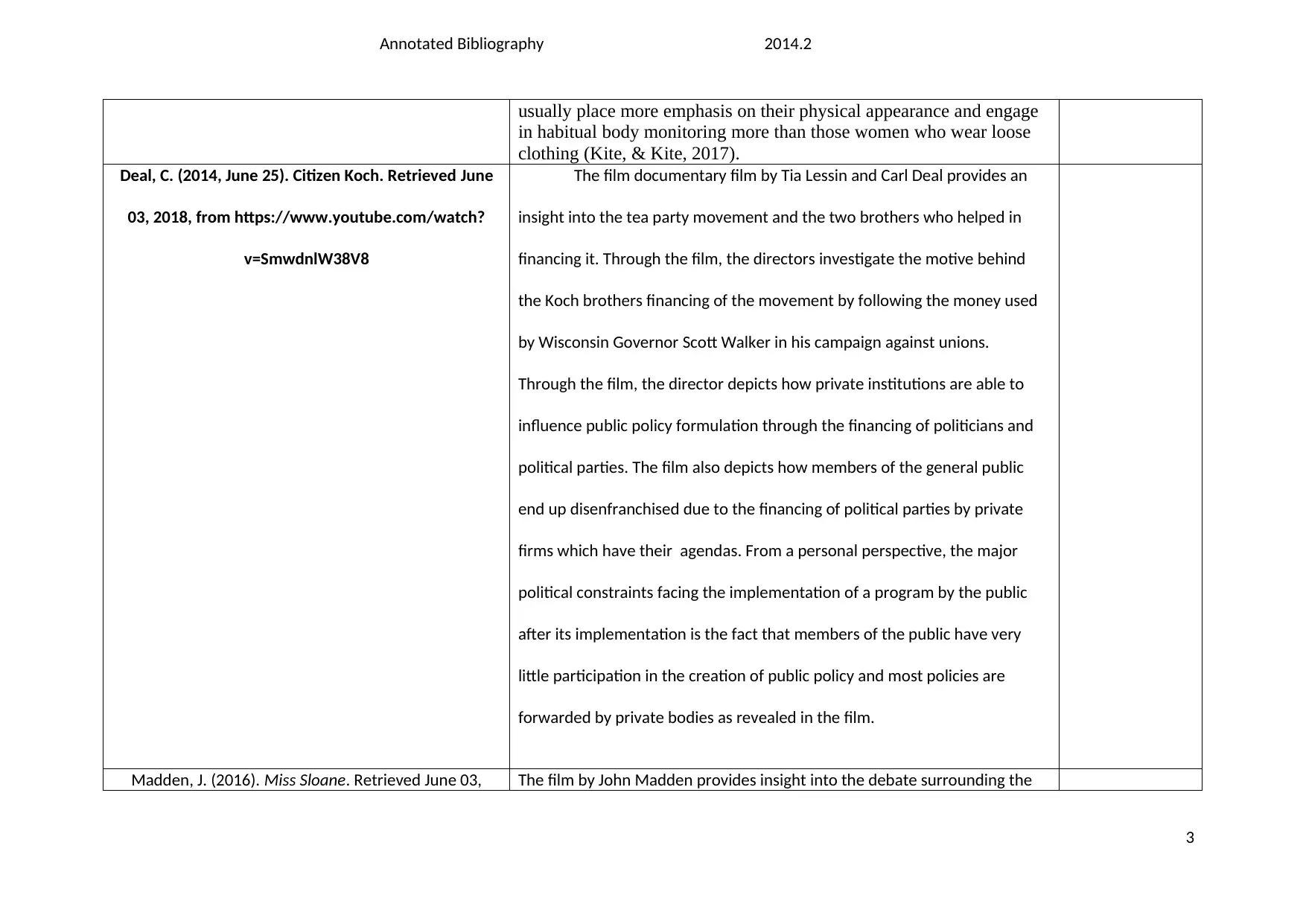
Annotated Bibliography 2014.2
usually place more emphasis on their physical appearance and engage
in habitual body monitoring more than those women who wear loose
clothing (Kite, & Kite, 2017).
Deal, C. (2014, June 25). Citizen Koch. Retrieved June
03, 2018, from https://www.youtube.com/watch?
v=SmwdnlW38V8
The film documentary film by Tia Lessin and Carl Deal provides an
insight into the tea party movement and the two brothers who helped in
financing it. Through the film, the directors investigate the motive behind
the Koch brothers financing of the movement by following the money used
by Wisconsin Governor Scott Walker in his campaign against unions.
Through the film, the director depicts how private institutions are able to
influence public policy formulation through the financing of politicians and
political parties. The film also depicts how members of the general public
end up disenfranchised due to the financing of political parties by private
firms which have their agendas. From a personal perspective, the major
political constraints facing the implementation of a program by the public
after its implementation is the fact that members of the public have very
little participation in the creation of public policy and most policies are
forwarded by private bodies as revealed in the film.
Madden, J. (2016). Miss Sloane. Retrieved June 03, The film by John Madden provides insight into the debate surrounding the
3
usually place more emphasis on their physical appearance and engage
in habitual body monitoring more than those women who wear loose
clothing (Kite, & Kite, 2017).
Deal, C. (2014, June 25). Citizen Koch. Retrieved June
03, 2018, from https://www.youtube.com/watch?
v=SmwdnlW38V8
The film documentary film by Tia Lessin and Carl Deal provides an
insight into the tea party movement and the two brothers who helped in
financing it. Through the film, the directors investigate the motive behind
the Koch brothers financing of the movement by following the money used
by Wisconsin Governor Scott Walker in his campaign against unions.
Through the film, the director depicts how private institutions are able to
influence public policy formulation through the financing of politicians and
political parties. The film also depicts how members of the general public
end up disenfranchised due to the financing of political parties by private
firms which have their agendas. From a personal perspective, the major
political constraints facing the implementation of a program by the public
after its implementation is the fact that members of the public have very
little participation in the creation of public policy and most policies are
forwarded by private bodies as revealed in the film.
Madden, J. (2016). Miss Sloane. Retrieved June 03, The film by John Madden provides insight into the debate surrounding the
3
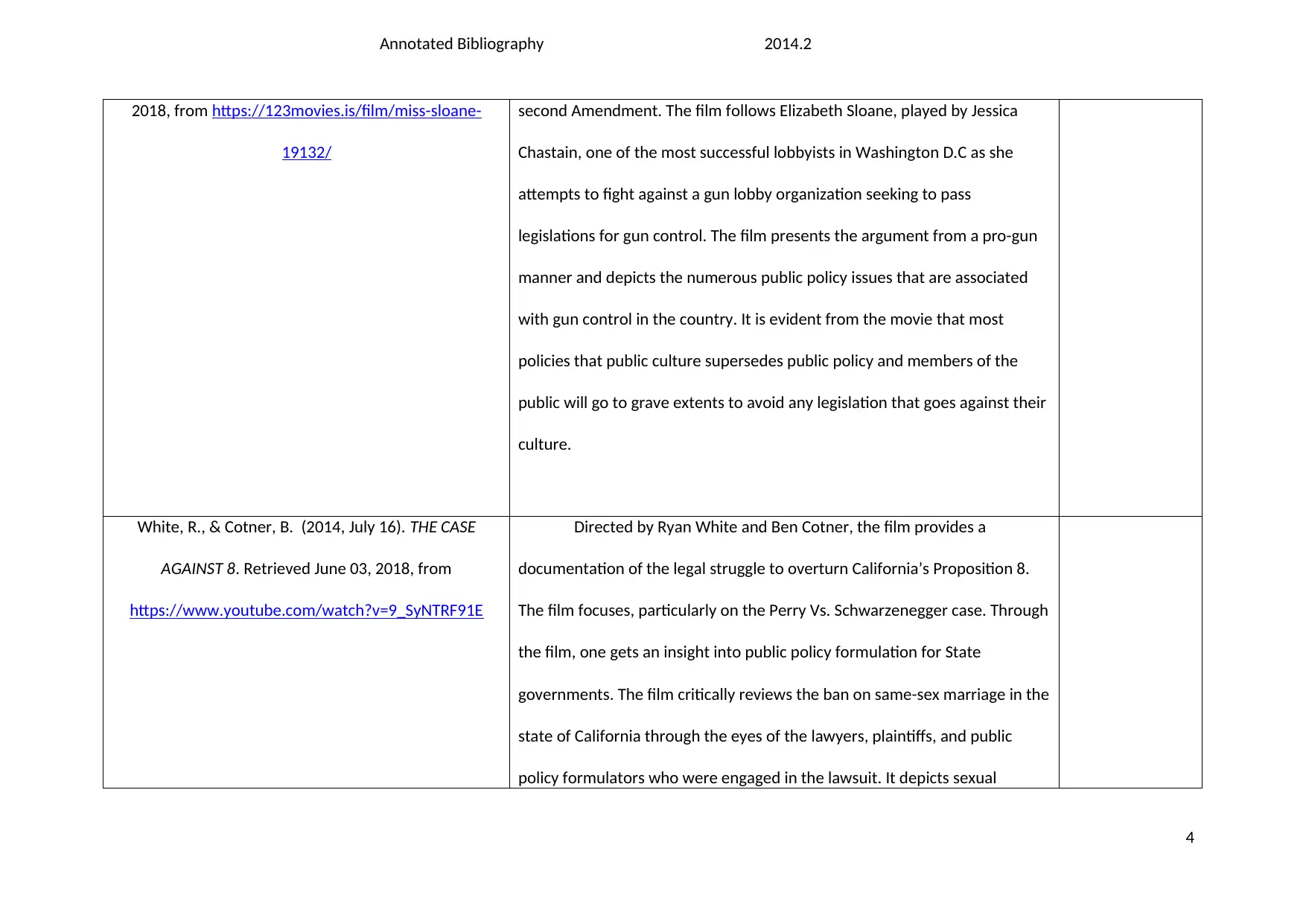
Annotated Bibliography 2014.2
2018, from https://123movies.is/film/miss-sloane-
19132/
second Amendment. The film follows Elizabeth Sloane, played by Jessica
Chastain, one of the most successful lobbyists in Washington D.C as she
attempts to fight against a gun lobby organization seeking to pass
legislations for gun control. The film presents the argument from a pro-gun
manner and depicts the numerous public policy issues that are associated
with gun control in the country. It is evident from the movie that most
policies that public culture supersedes public policy and members of the
public will go to grave extents to avoid any legislation that goes against their
culture.
White, R., & Cotner, B. (2014, July 16). THE CASE
AGAINST 8. Retrieved June 03, 2018, from
https://www.youtube.com/watch?v=9_SyNTRF91E
Directed by Ryan White and Ben Cotner, the film provides a
documentation of the legal struggle to overturn California’s Proposition 8.
The film focuses, particularly on the Perry Vs. Schwarzenegger case. Through
the film, one gets an insight into public policy formulation for State
governments. The film critically reviews the ban on same-sex marriage in the
state of California through the eyes of the lawyers, plaintiffs, and public
policy formulators who were engaged in the lawsuit. It depicts sexual
4
2018, from https://123movies.is/film/miss-sloane-
19132/
second Amendment. The film follows Elizabeth Sloane, played by Jessica
Chastain, one of the most successful lobbyists in Washington D.C as she
attempts to fight against a gun lobby organization seeking to pass
legislations for gun control. The film presents the argument from a pro-gun
manner and depicts the numerous public policy issues that are associated
with gun control in the country. It is evident from the movie that most
policies that public culture supersedes public policy and members of the
public will go to grave extents to avoid any legislation that goes against their
culture.
White, R., & Cotner, B. (2014, July 16). THE CASE
AGAINST 8. Retrieved June 03, 2018, from
https://www.youtube.com/watch?v=9_SyNTRF91E
Directed by Ryan White and Ben Cotner, the film provides a
documentation of the legal struggle to overturn California’s Proposition 8.
The film focuses, particularly on the Perry Vs. Schwarzenegger case. Through
the film, one gets an insight into public policy formulation for State
governments. The film critically reviews the ban on same-sex marriage in the
state of California through the eyes of the lawyers, plaintiffs, and public
policy formulators who were engaged in the lawsuit. It depicts sexual
4
Secure Best Marks with AI Grader
Need help grading? Try our AI Grader for instant feedback on your assignments.
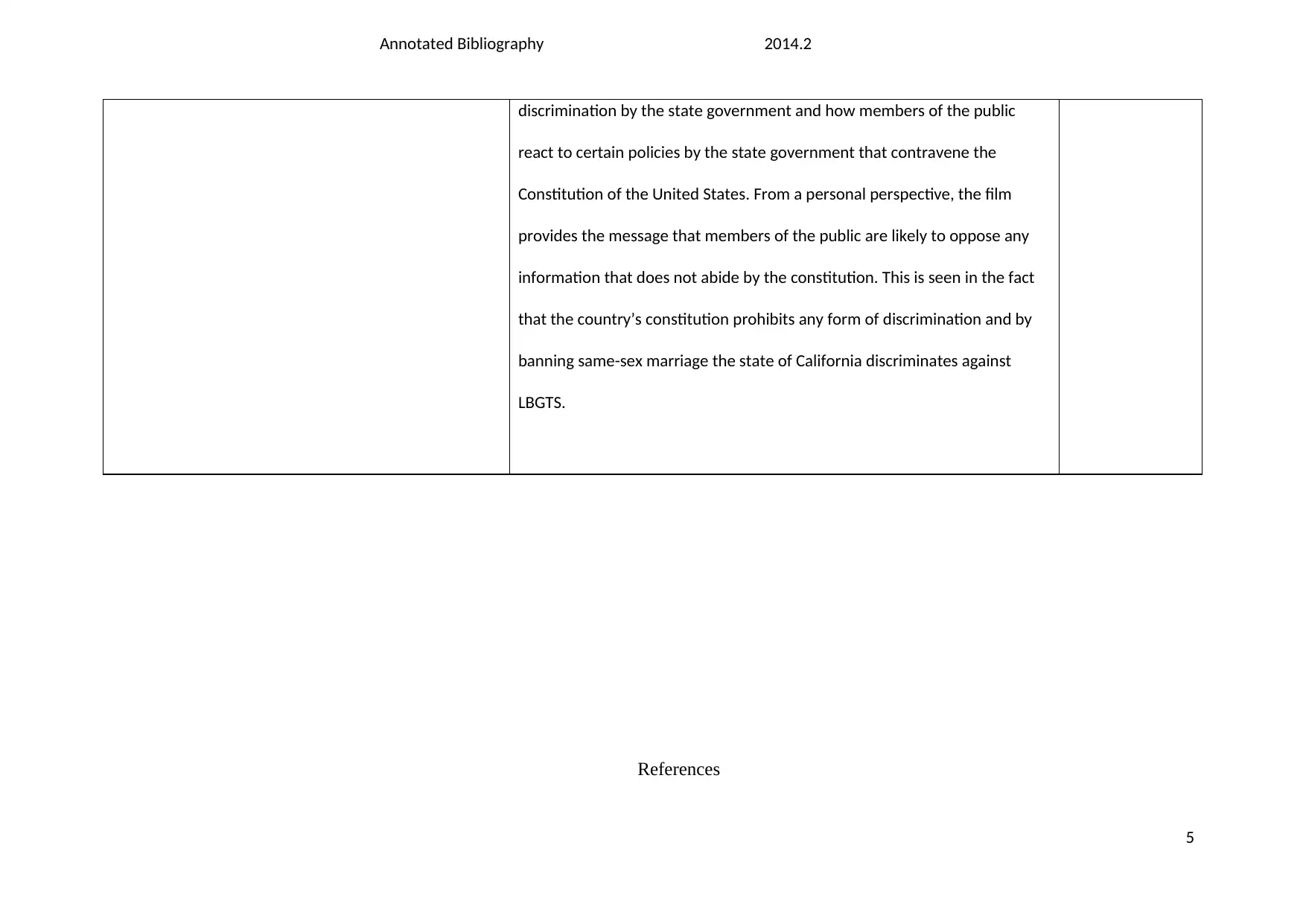
Annotated Bibliography 2014.2
discrimination by the state government and how members of the public
react to certain policies by the state government that contravene the
Constitution of the United States. From a personal perspective, the film
provides the message that members of the public are likely to oppose any
information that does not abide by the constitution. This is seen in the fact
that the country’s constitution prohibits any form of discrimination and by
banning same-sex marriage the state of California discriminates against
LBGTS.
References
5
discrimination by the state government and how members of the public
react to certain policies by the state government that contravene the
Constitution of the United States. From a personal perspective, the film
provides the message that members of the public are likely to oppose any
information that does not abide by the constitution. This is seen in the fact
that the country’s constitution prohibits any form of discrimination and by
banning same-sex marriage the state of California discriminates against
LBGTS.
References
5
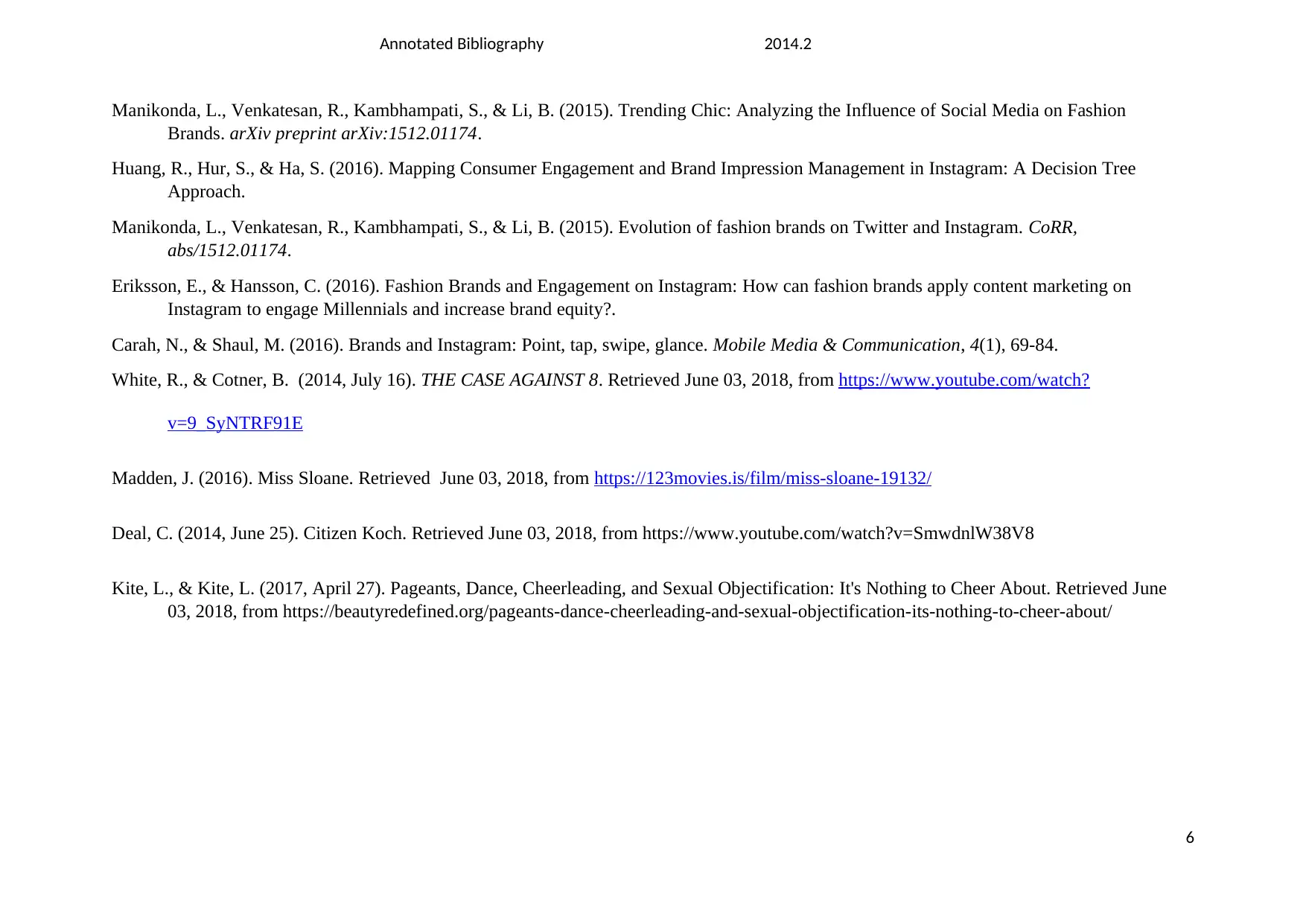
Annotated Bibliography 2014.2
Manikonda, L., Venkatesan, R., Kambhampati, S., & Li, B. (2015). Trending Chic: Analyzing the Influence of Social Media on Fashion
Brands. arXiv preprint arXiv:1512.01174.
Huang, R., Hur, S., & Ha, S. (2016). Mapping Consumer Engagement and Brand Impression Management in Instagram: A Decision Tree
Approach.
Manikonda, L., Venkatesan, R., Kambhampati, S., & Li, B. (2015). Evolution of fashion brands on Twitter and Instagram. CoRR,
abs/1512.01174.
Eriksson, E., & Hansson, C. (2016). Fashion Brands and Engagement on Instagram: How can fashion brands apply content marketing on
Instagram to engage Millennials and increase brand equity?.
Carah, N., & Shaul, M. (2016). Brands and Instagram: Point, tap, swipe, glance. Mobile Media & Communication, 4(1), 69-84.
White, R., & Cotner, B. (2014, July 16). THE CASE AGAINST 8. Retrieved June 03, 2018, from https://www.youtube.com/watch?
v=9_SyNTRF91E
Madden, J. (2016). Miss Sloane. Retrieved June 03, 2018, from https://123movies.is/film/miss-sloane-19132/
Deal, C. (2014, June 25). Citizen Koch. Retrieved June 03, 2018, from https://www.youtube.com/watch?v=SmwdnlW38V8
Kite, L., & Kite, L. (2017, April 27). Pageants, Dance, Cheerleading, and Sexual Objectification: It's Nothing to Cheer About. Retrieved June
03, 2018, from https://beautyredefined.org/pageants-dance-cheerleading-and-sexual-objectification-its-nothing-to-cheer-about/
6
Manikonda, L., Venkatesan, R., Kambhampati, S., & Li, B. (2015). Trending Chic: Analyzing the Influence of Social Media on Fashion
Brands. arXiv preprint arXiv:1512.01174.
Huang, R., Hur, S., & Ha, S. (2016). Mapping Consumer Engagement and Brand Impression Management in Instagram: A Decision Tree
Approach.
Manikonda, L., Venkatesan, R., Kambhampati, S., & Li, B. (2015). Evolution of fashion brands on Twitter and Instagram. CoRR,
abs/1512.01174.
Eriksson, E., & Hansson, C. (2016). Fashion Brands and Engagement on Instagram: How can fashion brands apply content marketing on
Instagram to engage Millennials and increase brand equity?.
Carah, N., & Shaul, M. (2016). Brands and Instagram: Point, tap, swipe, glance. Mobile Media & Communication, 4(1), 69-84.
White, R., & Cotner, B. (2014, July 16). THE CASE AGAINST 8. Retrieved June 03, 2018, from https://www.youtube.com/watch?
v=9_SyNTRF91E
Madden, J. (2016). Miss Sloane. Retrieved June 03, 2018, from https://123movies.is/film/miss-sloane-19132/
Deal, C. (2014, June 25). Citizen Koch. Retrieved June 03, 2018, from https://www.youtube.com/watch?v=SmwdnlW38V8
Kite, L., & Kite, L. (2017, April 27). Pageants, Dance, Cheerleading, and Sexual Objectification: It's Nothing to Cheer About. Retrieved June
03, 2018, from https://beautyredefined.org/pageants-dance-cheerleading-and-sexual-objectification-its-nothing-to-cheer-about/
6
1 out of 6
Your All-in-One AI-Powered Toolkit for Academic Success.
+13062052269
info@desklib.com
Available 24*7 on WhatsApp / Email
![[object Object]](/_next/static/media/star-bottom.7253800d.svg)
Unlock your academic potential
© 2024 | Zucol Services PVT LTD | All rights reserved.